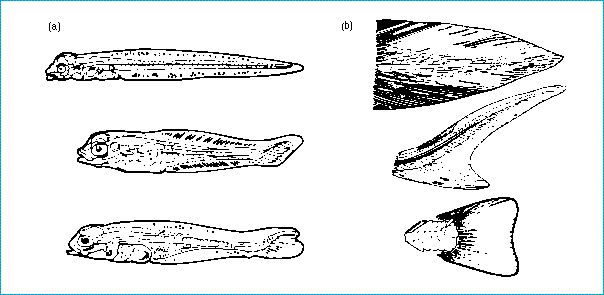Evolutionary developmental biology - How does evolutionary change in an organ occur?

An example: fish tails
An example of recapitulation, often quoted in the 19th century, is seen in the tail shapes of fish. During the development of an individual evolutionarily advanced fish species, such as the flatfish Pleuronectes, the tail has a diphycercal stage in the larva, and develops through a heterocercal stage, to the homocercal form of the adult.
Now, it is also possible to find different species of fish possessing these three tail types in the adult: lungfish, sturgeon, and salmon, on the right of the figure opposite are examples. The lungfish is thought to resemble most an early fish, the sturgeon to be a later stage, and the salmon to be the most recently evolved form. Thus evolution has proceded by adding on successive new stages to the end of development.
Let us symbolize the diphycercal, heterocercal, and homocercal tails by A , B , and C respectively. The development of the early fish advanced to stage A and then stopped. Then, in evolution, a new stage was added on to the end: the development of the fish at the second stage was A B ; the final type of development was A B C . Gould has called this mode of evolution terminal addition.
Figure: recapitulation, illustrated by fish tails. (a) The development of a modern teleost, the flatfish Pleuronectes, passes through (starting at the top) a diphycercal stage, to a stage in which the upper lobe of the tail is larger (heterocercal), and the adult has a tail with equal sized lobes (homocercal). (b) Adult forms in order of evolution of tail form, from top to bottom: lungfish (diphycercal), sturgeon (heterocercal), salmon (homocercal).
| Next |



